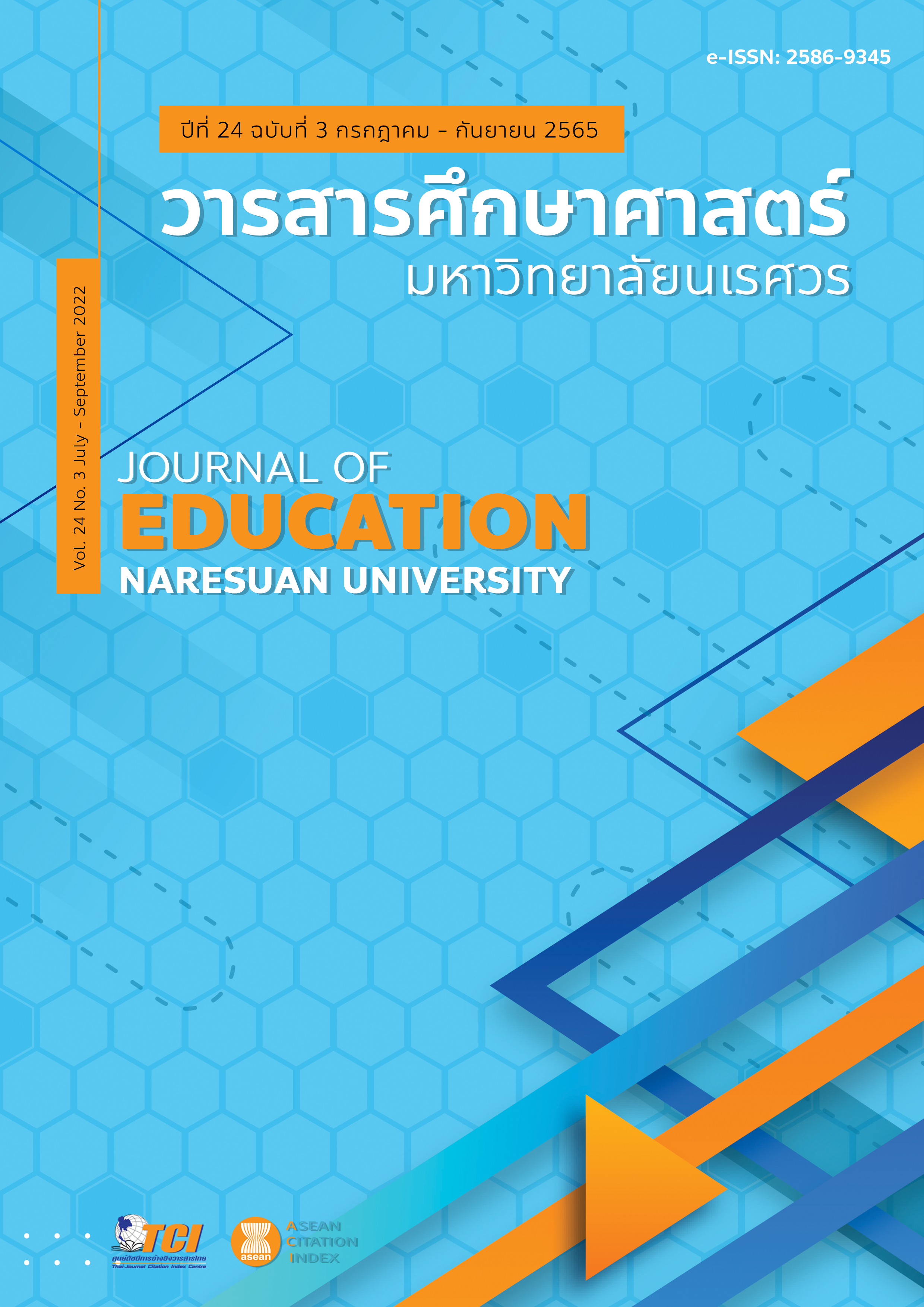THE RESULTS OF USING THE CREATIVE LEARNING ACTIVITIES BY APPLYING THE MOTIF FOR ENHANCING THE CONCEPT ON MOTIF IN FOLKTALE, CREATIVE WRITING ABILITY AND DEVELOP STUDENTS' ABILITIES IN THE 21st CENTURY ผลการใช้กิจกรรมการเรียนรู้เชิงสร้างสรรค์โดยประยุกต์ใช้อนุภาคเพื่อส่งเสริมมโนทัศน์ เรื่องอนุภาคในนิทานพื้นบ้าน ความสามารถด้านการเขียนเชิงสร้างสรรค์และพัฒนาความสามารถของผู้เรียนในศตวรรษที่ 21
Main Article Content
Abstract
The purposes of this research were, 1) to study the results of using Creative Learning Activities to sample group and disseminate group regarding the concept of motif in the folktale, creative writing ability, and students' abilities in the 21st century which consisted of creative thinking, collaboration and cross cultural understanding, and study the opinions of the sample group and disseminate group after using Creative Learning Activities. And 2) to study the results of using the folktale as a medium in classroom. The samples of this research were 2 groups. The first sample group for testing was the 2nd year students of Thai language teaching major, Faculty of Education, Silpakorn University. The second group for dissemination about the results of research were the 2nd year students of Thai language teaching major, Faculty of Education, Kanchanaburi Rajabhat University, teachers and students in Prathomsuksa 4 of Demonstration School of Silpakorn University, and teachers and students in Mathayomsuksa 3 of Benchamatheputhit School, Phetchaburi. The research instruments were motif concept ability test, creative writing ability test, creative thinking ability test, cross cultural understanding ability test, collaborative observation form , the question for opinion reflection and questionnaire forms. The mean, standard deviation of items, t- test dependent and content analysis were used to analyse the data. The research findings separated into 2 parts, they are: 1) The results of using the Creative Learning Activities. All abilities of 2 groups of students included that;
(1) motif concept ability, (2) creative writing ability, (3) students’ abilities in 21st century that; (3.1) creative thinking ability, (3.2) cultural understanding ability were higher than before using the Creative Learning Activities with .05 level of statistical significance, and (3.3) collaborative ability were higher than before using the Creative Learning Activities too. And (4) students’ opinion reflection about the benefits of Creative Learning Activities can be categorized into five topics as follow; 1) developing student’s creative thinking, 2) the benefits for story writing, 3) learning with happiness, 4) build on a teaching career based on the knowledge gained, and 5) enhancing collaboration, understanding people and different culture. 2) The results of using the folktale as a medium in classroom revealed that the teachers and students of Mathayomsuksa and Prathomsuksa levels who were teaching and studying Thai language as a subject had high level of agreement opinions about creative folktales can be used as a medium in classroom. Both teachers and students had high level of positive opinions that the content of creative folktales had high imagination, creative thinking got reflected through creative folktales and benefits of creative folktales can be used in real classroom too.
Article Details

This work is licensed under a Creative Commons Attribution-NonCommercial-NoDerivatives 4.0 International License.
The owner of the article does not copy or violate any of its copyright. If any copyright infringement occurs or prosecution, in any case, the Editorial Board is not involved in all the rights to the owner of the article to be performed.
References
Anuntasarn, S. (2009). Contemporary folklore theories. Bangkok: Ramkhamhaeng University. [in Thai]
Dachakupt, P., & Yindeesuk, P. (2015). Learning management in 21st century. Bangkok: Chulalongkorn University Printing House. [in Thai]
Homfung, C. (2019). The development of creative learning activities to teach motif in folktale and develop students' abilities in the 21st century. Proceeding of Joint International Education Conference: The 8th PSU Education Conference & 4th Inspirational Scholar Symposium (ISS) 2019 “Growth Mindset Innovative and Integrated Work-Ready Education” (pp. 174-181). Thailand.
Khammani, T. (2007). The science of teaching. Bangkok: Chulalongkorn University Printing House. [in Thai]
Kuriyama, K., & Schwartz, A. W. (2015). Teaching language, culture, and literature together to enhance trans-cultural competence and L2 proficiency. Notandum, 39, 21-39.
Laowreandee, W. (2017). The Active Learning strategies to develop thinking and enhance quality of education in 21st century. Nakornprathom: Phetkasam printing group.
Na Thalang, S. (2009). The folklore theory: methodology to analyze legend and the folktale. Bangkok: Chulalongkorn University Printing House. [in Thai]
Olusegun. (2015). Constructivism learning theory: A paradigm for teaching and learning. Journal of Research & Method in Education (IOSR-JRME), 5(6), 66-70.
Patjusanon, S. (2017). The creation of magic motif in fantasy novel the white road (Master thesis). Chonburi: Burapha University. [in Thai]
Petthong, Th. (2018). A development of Thai grammatical learning achievement on sentences of grade 8 students using RM3S based on constructivism theory (Master thesis). Nakornprathom: Silpakorn University. [in Thai]
Ruamsuk, P. (2015). The development of tales to enhance generosity in children in early childhood (Master thesis). Nakornprathom: Mahidol University. [in Thai]
Schunk, D. H. (1996). Learning theories (2nd ed.). Englewood Cliffs: Merrill Prentice Hall.
Thompson, S. (1977). The folktale. Berkeley: University of California Press.
Totten, S., Sills, T., Digby, A., & Russ, P. (1991). Cooperative learning: A guide to research. New York: Garland.
Vetchasart, K. (2019). The problems in teaching motif. [Interviewed by Homfung, C.]


